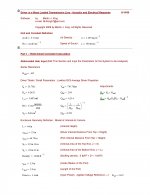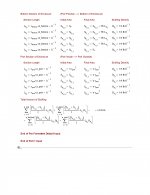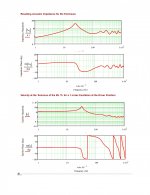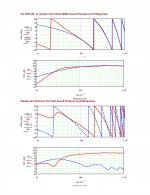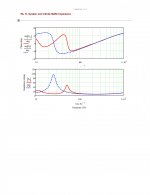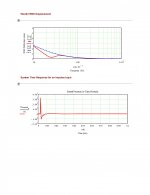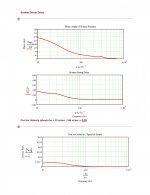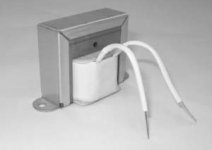But, mass aside, Qms is a direct measure of mechnical energy storage. A low Qms driver has lower mechanical energy storage. So his comment is still backwards.Mass alone does not dictate energy storage.
If I remember my T/S correctly - not so.
Qms is a measure of damping effectiveness. Specifically, it is a dimensionless number - crudely a ratio between energy storage (eg. sprung weight Mms) and energy loss (eg. damper setting Rms).
It tells you nothing about the ability to store energy - the only places to store energy are potential (in the spring eg. 1/Cms) and kinetic - in moving mass (Mms).
Just bumping up Mms will raise Qms. But adding Rms will reduce it.
If I remember my T/S correctly - not so.
Qms is a measure of damping effectiveness. Specifically, it is a dimensionless number - crudely a ratio between energy storage (eg. sprung weight Mms) and energy loss (eg. damper setting Rms).
It tells you nothing about the ability to store energy - the only places to store energy are potential (in the spring eg. 1/Cms) and kinetic - in moving mass (Mms).
Just bumping up Mms will raise Qms. But adding Rms will reduce it.
How does any of this contradict what I said ? I said mass alone does not dictate energy storage, as implied by Elias. You've just told me increasing mass increases energy storage while increasing Rms decreases it.
Now go and look at the T/S equation for Qms. See a connection ?
Last edited:
How does any of this contradict what I said ? I said mass alone does not dictate energy storage, as implied by Elias. You've just told me increasing mass increases energy storage while increasing Rms decreases it.
Now go and look at the T/S equation for Qms. See a connection ?
You don't understand what "energy storage" means. The energy initially stored into a device, and the rate by which it is consumed are two different things.
It seems that all but the soft dome tweeters are the same way I see it.Some interesting comments from Joachim Gerhard that cover parts of the discussions we had here last week (high Qms/low Rms, and trend in modern drivers)
SpeakerBuilding.com - Interview with Joachim Gerhard of Audio Physic
http://profesional.beyma.com/pdf/SM-112 NE.pdf
Beyma SM112 is another high Qms(12.4), low Rms(1.32) 12" driver.
Very reasonably priced as well.
I would love to try this for 100-800Hz on open baffle or nude.
My only concern for OB is the size of the magnet; there is not much breathing space at the back.
So I purchased a pair of second hand Faital Pro 12PR300 neo driver instead. Will see how it works.
Beyma SM112 is another high Qms(12.4), low Rms(1.32) 12" driver.
Very reasonably priced as well.
I would love to try this for 100-800Hz on open baffle or nude.
My only concern for OB is the size of the magnet; there is not much breathing space at the back.
So I purchased a pair of second hand Faital Pro 12PR300 neo driver instead. Will see how it works.
just for fun, I suggest some compression driver owners who use higher xover to roll up a quick Karlson tube from a sheet of paper and some tape - make it 1" inside diameter perhaps 6" overall length, and with scissor cut an ellipse based slot ~5.5" long tapering down to around 1/8". The tube could be used pointing forwards or more typically, elevated up to as much as 30 degrees.
I'd like to thank LineSource for this recent posting about the alignment that Jean Hiraga might be using for his 604-Duplex loudspeaker. Since Bill of GPA informs me that the GPA 604 and GPA 416 use the same cone and magnet system, whatever alignment that works for the current-production 604 should also work for the current-production 416. (Note the use of the phrase "current-production".)
I should mention that Altec, even back in the Fifties and Sixties, made unannounced production changes to the 416 and 515 that altered the Theile/Small parameters of the drivers.
This went largely unnoticed because the first Neville Theile and Richard Small papers were not published in the AES Journal until 1973, if memory serves, and published measurements of professional Altec and JBL drivers didn't start appearing until a year or so later. That's when people discovered the year-by-year production variations of the Altec and JBL drivers. (Production standards tightened up after Altec and JBL started publishing Theile/Small parameters in the product brochures, since customers could easily check the T/S parameters for themselves.)
It's a little dangerous to design around old drivers, because of magnet aging and production variations, especially in the pre-Theile/Small days. It begs the question ... which 416 or 515, made when?
I've opened up two beautiful cast-aluminum cans for Altec A5 crossovers, and discovered that the caps in each channel were not only cheapest-possible Mylar caps, but not the same vendor between the two different channels, even though the serial numbers on the two crossover cans were sequential. In other words, Altec just used the parts that were the cheapest at the time; I suspect the cast-aluminum cans actually cost more than the parts inside.
Don't be fooled by the pretty cast-aluminum cans; they add nothing to the sound (a plain wood box would be better electrically, since no eddy currents would be induced in the container) and conceal the dodgy parts inside. At least the parts weren't potted; that would be a nightmare to remove, and again, adds nothing to the sound.
The 288 and 515 drivers, of course, were beautifully made, but not as gorgeous as JBLs, which were always champs in the looks department.
It would be interesting to see Stephens Tru-Sonic revived; the old-timers I've met told me that they were the best-sounding drivers and loudspeakers of the early and mid-Fifties. My understanding is that Stephens was part of the Wente and Thuras team at ERPI in the late Thirties, and was the inventor of the multicell horn.
I should mention that Altec, even back in the Fifties and Sixties, made unannounced production changes to the 416 and 515 that altered the Theile/Small parameters of the drivers.
This went largely unnoticed because the first Neville Theile and Richard Small papers were not published in the AES Journal until 1973, if memory serves, and published measurements of professional Altec and JBL drivers didn't start appearing until a year or so later. That's when people discovered the year-by-year production variations of the Altec and JBL drivers. (Production standards tightened up after Altec and JBL started publishing Theile/Small parameters in the product brochures, since customers could easily check the T/S parameters for themselves.)
It's a little dangerous to design around old drivers, because of magnet aging and production variations, especially in the pre-Theile/Small days. It begs the question ... which 416 or 515, made when?
I've opened up two beautiful cast-aluminum cans for Altec A5 crossovers, and discovered that the caps in each channel were not only cheapest-possible Mylar caps, but not the same vendor between the two different channels, even though the serial numbers on the two crossover cans were sequential. In other words, Altec just used the parts that were the cheapest at the time; I suspect the cast-aluminum cans actually cost more than the parts inside.
Don't be fooled by the pretty cast-aluminum cans; they add nothing to the sound (a plain wood box would be better electrically, since no eddy currents would be induced in the container) and conceal the dodgy parts inside. At least the parts weren't potted; that would be a nightmare to remove, and again, adds nothing to the sound.
The 288 and 515 drivers, of course, were beautifully made, but not as gorgeous as JBLs, which were always champs in the looks department.
It would be interesting to see Stephens Tru-Sonic revived; the old-timers I've met told me that they were the best-sounding drivers and loudspeakers of the early and mid-Fifties. My understanding is that Stephens was part of the Wente and Thuras team at ERPI in the late Thirties, and was the inventor of the multicell horn.
Last edited:
How inmportant is the bass shelf that Line Source designed into his sim. I have heard opposing views about whether to go maximally flat or build to room.
BTW, Here is a sim of my drivers in a down firig box that has a lot of tunability in terms of the LF, by either varying port or stuffing. May try it with linesource's idea.
BTW, Here is a sim of my drivers in a down firig box that has a lot of tunability in terms of the LF, by either varying port or stuffing. May try it with linesource's idea.
Attachments
Last edited:
While I'm almost always in agreement with Lynn's writing (the parts I can comprehend) I have to say that I like mylar caps at least some of them like ERO MKT green sqares. I'm not sure the reason but when you look at gear perceived as very musical : shindo , audio note , leben you won't find PP caps only PIOs and mylars. Myself If I have choice between cheap pp cap and mylar I go for mylar . Only if I want to sell something I put shinny poly caps otherwise "morons" would not consider it  Rgrds, L
Rgrds, L
Limono,
Mylar is just a trade name for polyester film caps. Most regard a polypropylene or polystyrene as the most linear of the film types of capacitor as used in a passive crossover design. You have to also look at the construction methods used as these can be film and foil, metalized and also radial or axial construction. Mylar would be my least used in any of these applications except if I couldn't find a value or was making something that I didn't care as much about like a car stereo application.
Mylar is just a trade name for polyester film caps. Most regard a polypropylene or polystyrene as the most linear of the film types of capacitor as used in a passive crossover design. You have to also look at the construction methods used as these can be film and foil, metalized and also radial or axial construction. Mylar would be my least used in any of these applications except if I couldn't find a value or was making something that I didn't care as much about like a car stereo application.
yes , not all polyester caps sound OK and I'm not that sensitive to sound of caps anyway just it's worth noting that there is a fraction which can't stand the sound of poly caps I think Peter Qvortrup wrote something about sound of thousands piercing needles. At the moment I'm looking for best bipolar electrolitycs in 8uF , 12uF and something smaller to make odd values . Anybody got those horrible standard blue Black gates ?
The crossovers I opened dated from the early Seventies, long before anyone thought caps had any sound at all. Jung's article on caps was published in 1979, and that started people thinking about parts quality in a different way.
My disappointment when I opened the Altec A5 crossover cans was the sharp distinction between the quite expensive cast-aluminum box (cast aluminum was and is plenty expensive, even for Altec) and seriously cheapo parts inside ... and the dismaying discovery that caps appeared to be picked out of a random parts bin. Values were nominally the same, but the vendor wasn't. The L-pads between the 2nd-order highpass filter and the 288 compression driver were a step below Radio Shack quality, and were both severely corroded ... a pretty good indication that neither box had ever been opened.
Although I like Altec drivers, to be honest, the crossovers they used were very primitive ... textbook 2nd-order highpass and textbook 2nd-order lowpass, going back to the bad old M-derived filter-theory days of the Thirties. Altec (and JBL) were using textbook crossovers 10~15 years after the BBC (and other Brits) started using pretty sophisticated crossovers.
The Big Two West Coast manufacturers were coasting on the reputation built in the late Thirties, and were ignoring the Brits and the fantastic work of a local boy at CalTech, Dr. Richard Heyser. Looking back what Altec and JBL were doing in the early Seventies, it was very much a Not-Invented-Here town, with no attempt to make time measurements, much less CSD plots (which the BBC and Heyser were doing), and very simple 1st and 2nd-order crossovers that did not equalize the drivers.
None of that takes anything away from the drivers, which were designed in the mid-to-late Forties, and represented the best thinking of the time.
My disappointment when I opened the Altec A5 crossover cans was the sharp distinction between the quite expensive cast-aluminum box (cast aluminum was and is plenty expensive, even for Altec) and seriously cheapo parts inside ... and the dismaying discovery that caps appeared to be picked out of a random parts bin. Values were nominally the same, but the vendor wasn't. The L-pads between the 2nd-order highpass filter and the 288 compression driver were a step below Radio Shack quality, and were both severely corroded ... a pretty good indication that neither box had ever been opened.
Although I like Altec drivers, to be honest, the crossovers they used were very primitive ... textbook 2nd-order highpass and textbook 2nd-order lowpass, going back to the bad old M-derived filter-theory days of the Thirties. Altec (and JBL) were using textbook crossovers 10~15 years after the BBC (and other Brits) started using pretty sophisticated crossovers.
The Big Two West Coast manufacturers were coasting on the reputation built in the late Thirties, and were ignoring the Brits and the fantastic work of a local boy at CalTech, Dr. Richard Heyser. Looking back what Altec and JBL were doing in the early Seventies, it was very much a Not-Invented-Here town, with no attempt to make time measurements, much less CSD plots (which the BBC and Heyser were doing), and very simple 1st and 2nd-order crossovers that did not equalize the drivers.
None of that takes anything away from the drivers, which were designed in the mid-to-late Forties, and represented the best thinking of the time.
Last edited:
Lyon,
Extrapolating from what you are saying I will add in that JBL and Altec at the time just acted as if the crossover components were completely interchangeable, that is what you are seeing. As long as the value was electrical component met a minimum standard like it was plus or minus 10% it was the same and would sound the same. We all know now that isn't true and I bet they more than likely did also, but just ignored it as they could get away with that. The same guys designing those great drivers of the time we just as capable as anyone at designing better crossovers. As you say Heyser was in California and there were just to many others who knew what was going on. When you control the market for the products why change was the thinking.
Extrapolating from what you are saying I will add in that JBL and Altec at the time just acted as if the crossover components were completely interchangeable, that is what you are seeing. As long as the value was electrical component met a minimum standard like it was plus or minus 10% it was the same and would sound the same. We all know now that isn't true and I bet they more than likely did also, but just ignored it as they could get away with that. The same guys designing those great drivers of the time we just as capable as anyone at designing better crossovers. As you say Heyser was in California and there were just to many others who knew what was going on. When you control the market for the products why change was the thinking.
Although Altec (and JBL) were using primitive crossovers, Altec did start to introduce Acousta-Voice 1/3 octave theater equalizers. I imagine there was a fair amount of market resistance, because theaters were scaling down at the time. Big theaters with 70mm 6-channel mag-track were phased out, replaced by mini-screens in multiplexes with 35mm optical-mono sound ... going right back to Forties exhibition technology. The so-called "wide-screen" movies (1:1.85 aspect ratio) were nothing more than matted-out 35mm, with the top and bottom of the frame blanked out, resulting in a movie frame with less area than the Forties-era Academy frame. Not an ideal market to sell better sound.
The A2, A4, and A5 were not flat, with a 3~6 dB peak around 1.5 kHz, and a HF rolloff above 3.5 kHz, thanks to the perforated screen. But in a sense it didn't matter, since movies made in the Forties, Fifties, and Sixties were mixed and equalized with the A-series in mind.
Sound quality in the Seventies could be described as low-fi, since quality 70mm mag-track exhibition had disappeared, and brutal-sounding Crown DC300 and Phase Linear 700's were replacing old, worn-out vacuum-tube amplifiers. A few theaters were Acousta-Voiced, but most weren't, since few movies had anything better than mono optical soundtracks. Star Wars was the first Hollywood movie to re-introduce stereo sound, after a long absence, and even that was simply Dolby stereo-optical, a technique first invented and patented by A.D. Blumlein in the mid-Thirties.
I can see why there was a push for some kind of improvement in the late Seventies and early Eighties (THX standardization). The 35mm theater owners were using the cheapest projectors and sound equipment they could get away with, while directors wanted to re-introduce stereo sound with the kind of quality associated with 70mm mag-track and good home hifi systems (which had long surpassed theaters in sound quality). Thus, THX certification, JBL theater loudspeakers, and the mixed blessing of heavily-compressed AC3/Dolby Digital sound.
The A2, A4, and A5 were not flat, with a 3~6 dB peak around 1.5 kHz, and a HF rolloff above 3.5 kHz, thanks to the perforated screen. But in a sense it didn't matter, since movies made in the Forties, Fifties, and Sixties were mixed and equalized with the A-series in mind.
Sound quality in the Seventies could be described as low-fi, since quality 70mm mag-track exhibition had disappeared, and brutal-sounding Crown DC300 and Phase Linear 700's were replacing old, worn-out vacuum-tube amplifiers. A few theaters were Acousta-Voiced, but most weren't, since few movies had anything better than mono optical soundtracks. Star Wars was the first Hollywood movie to re-introduce stereo sound, after a long absence, and even that was simply Dolby stereo-optical, a technique first invented and patented by A.D. Blumlein in the mid-Thirties.
I can see why there was a push for some kind of improvement in the late Seventies and early Eighties (THX standardization). The 35mm theater owners were using the cheapest projectors and sound equipment they could get away with, while directors wanted to re-introduce stereo sound with the kind of quality associated with 70mm mag-track and good home hifi systems (which had long surpassed theaters in sound quality). Thus, THX certification, JBL theater loudspeakers, and the mixed blessing of heavily-compressed AC3/Dolby Digital sound.
Last edited:
Although Altec (and JBL) were using primitive crossovers, Altec did start to introduce Acousta-Voice 1/3 octave theater equalizers.
And yet they used the most linear inductor style ever. And, they would not have been the least expensive.
The Xovers I have seen, and not an abundance of them either, used a non saturable reactor. Somewhat of a misnomer, but they provide linearization of flux in the coil, including smooth settling, but do not suffer from the usual gaped choke problems or the nonlinear clumping of inductance in air coils.
Attachments
Looks like the I is on the back of the E. One big air gap? How do cored inductors behave on very low level signals, when the inductance drops off? I understood more constant inductance was the idea of air cores. But in a cinema probably that was not an issue. Or I maybe these are for lower cross over points than practical with air core perhaps.
martin
martin
The effective permeability of a core constructed like this is 45, rather than a few, to many tens of thousands. What the core is doing is just ordering what is otherwise a disorderly rise and fall of inductance in the windings. Also, since the core is basically inert regardless of the frequency, the typical distortion addition is not a factor. You, of course, do not want to mount these onto a steel plate....
- Home
- Loudspeakers
- Multi-Way
- Beyond the Ariel
